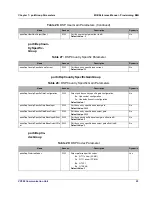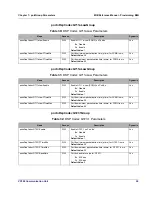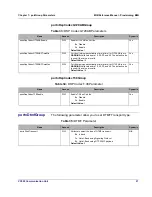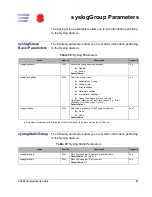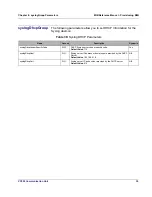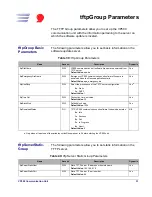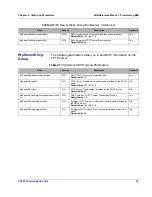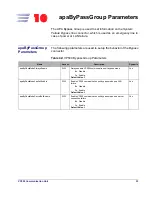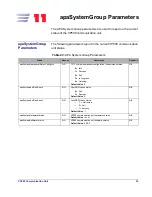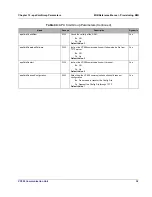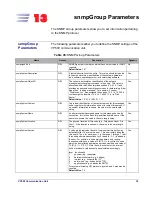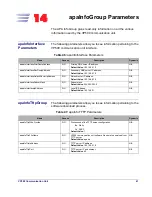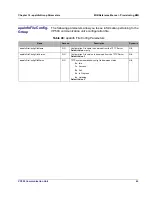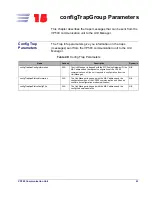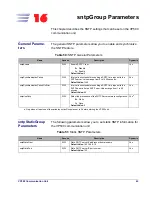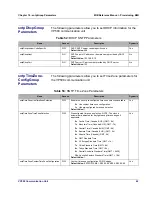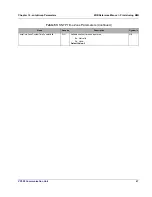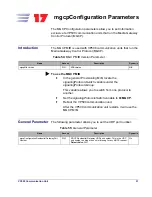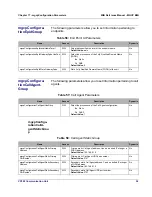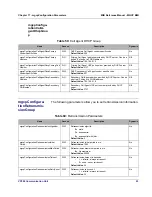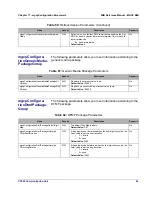
VP500 Communication Unit
39
13
snmpGroup Parameters
The SNMP Group parameters allow you to set information pertaining
to the SNMP protocol.
snmpGroup
Parameters
The following parameters allow you to define the SNMP settings of the
VP500 communication unit.
Table 45:
SNMP Group Parameters
Name
Access
Description
Dynamic
snmpAgentPort
R/W
SNMP Agent port number on which the unit must listen for SNMP
requests.
Default Value
: 161
No
snmpSystemDescription
R/W
A textual description of the entity. This value should include the
full name and version identification of the system’s hardware
type, software operating system, and networking software.
Yes
snmpSystemObjectID
R/W
The vendor's authoritative identification of the network
management subsystem contained in the entity. This value is
allocated within the SMI enterprises subtree (1.3.6.1.4.1) and
provides an easy and unambiguous means for determining “what
kind of box” is being managed. For example, if vendor
“Flintstones, Inc.” was assigned the subtree 1.3.6.1.4.1.4242, it
could assign the identifier 1.3.6.1.4.1.4242.1.1 to its “Fred
Router”.
Default Value
: 1.3.6.1.4.1.4935.1.1.1.1
Yes
snmpSystemContact
R/W
The textual identification of the contact person for this managed
node, together with information on how to contact this person. If
no contact information is known, the value is the zero-length
string.
Yes
snmpSystemName
R/W
An administratively-assigned name for this managed node. By
convention, this is the node’s fully-qualified domain name. If the
name is unknown, the value is the zero-length string.
Yes
snmpSystemLocation
R/W
The physical location of this node (e.g., “telephone closet, 3rd
floor”). If the location is unknown, the value is the zero-length
string.
Yes
snmpSystemService
R/W
A value which indicates the set of services that this entity may
potentially offer. The value is a sum. This sum initially takes the
value zero, Then, for each layer, L, in the range 1 through 7, that
this node performs transactions for, 2 raised to (L - 1) is added to
the sum. For example, a node which performs only routing
functions would have a value of 4 (2^(3-1)). In contrast, a node
which is a host offering application services would have a value of
72 (2^(4-1) + 2^(7-1)). Note that in the context of the Internet
suite of protocols, values should be calculated accordingly:
layer functionality
1 physical (e.g., repeaters)
2 datalink/subnetwork (e.g., bridges)
3 internet (e.g., supports the IP)
4 end-to-end (e.g., supports the TCP)
7 applications (e.g., supports the SMTP)
For systems including OSI protocols, layers 5 and 6 may also be
counted.
Default Value
: 72
Yes
Summary of Contents for MIB Structure (SIP/MGCP/NCS)
Page 1: ...MIB Structure SIP MGCP NCS Reference Manual VoIPTalk Rev C...
Page 8: ...Contents MIB Reference Manual VP500 Communication Unit viii...
Page 15: ...Part 1 Provisioning MIB...
Page 16: ......
Page 59: ...Part 2 MGCP MIB...
Page 60: ......
Page 67: ...Part 3 SIP MIB...
Page 68: ......

